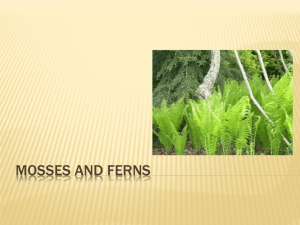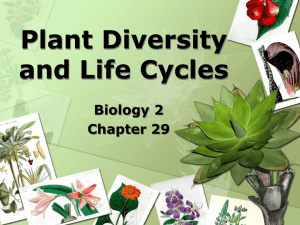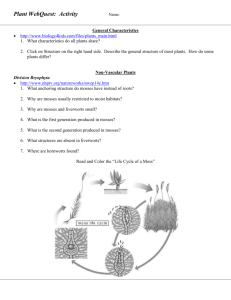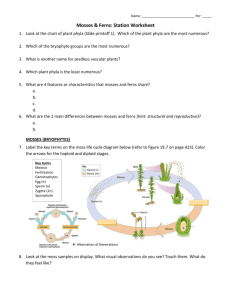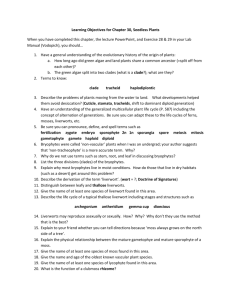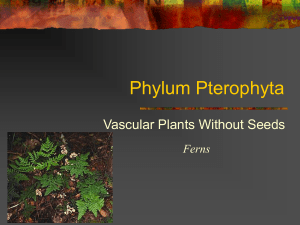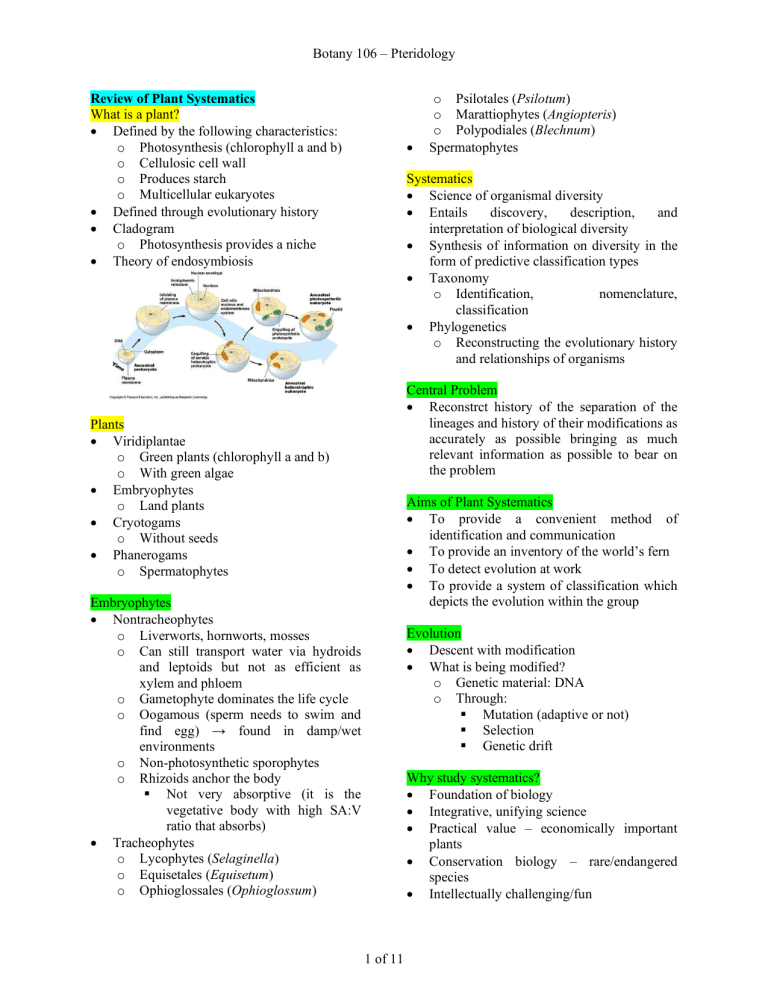
Botany 106 – Pteridology Review of Plant Systematics What is a plant? • Defined by the following characteristics: o Photosynthesis (chlorophyll a and b) o Cellulosic cell wall o Produces starch o Multicellular eukaryotes • Defined through evolutionary history • Cladogram o Photosynthesis provides a niche • Theory of endosymbiosis • o Psilotales (Psilotum) o Marattiophytes (Angiopteris) o Polypodiales (Blechnum) Spermatophytes Systematics • Science of organismal diversity • Entails discovery, description, and interpretation of biological diversity • Synthesis of information on diversity in the form of predictive classification types • Taxonomy o Identification, nomenclature, classification • Phylogenetics o Reconstructing the evolutionary history and relationships of organisms Central Problem • Reconstrct history of the separation of the lineages and history of their modifications as accurately as possible bringing as much relevant information as possible to bear on the problem Plants • Viridiplantae o Green plants (chlorophyll a and b) o With green algae • Embryophytes o Land plants • Cryotogams o Without seeds • Phanerogams o Spermatophytes Aims of Plant Systematics • To provide a convenient method of identification and communication • To provide an inventory of the world’s fern • To detect evolution at work • To provide a system of classification which depicts the evolution within the group Embryophytes • Nontracheophytes o Liverworts, hornworts, mosses o Can still transport water via hydroids and leptoids but not as efficient as xylem and phloem o Gametophyte dominates the life cycle o Oogamous (sperm needs to swim and find egg) → found in damp/wet environments o Non-photosynthetic sporophytes o Rhizoids anchor the body ▪ Not very absorptive (it is the vegetative body with high SA:V ratio that absorbs) • Tracheophytes o Lycophytes (Selaginella) o Equisetales (Equisetum) o Ophioglossales (Ophioglossum) Evolution • Descent with modification • What is being modified? o Genetic material: DNA o Through: ▪ Mutation (adaptive or not) ▪ Selection ▪ Genetic drift Why study systematics? • Foundation of biology • Integrative, unifying science • Practical value – economically important plants • Conservation biology – rare/endangered species • Intellectually challenging/fun 1 of 11 Botany 106 – Pteridology • General Descriptions of Cryptogams Alternation of Generations • Sexual and asexual phases (often morphologically distinct) o Alternation of dimorphic forms o Distinct in number of chromosomes • Presence of distinct multicellular forms • Stages of ontogenetic development of an organism • Haplo-diplontic life cycle o Haplo = sexual o Diplo = asexual Sporophyte o Leaves, stems, roots o Does the vegetative activities of the plant Advantage of 2 Forms • Allows each to exploit different environments o Tiny spores allow genes to travel far beyond the immediate vicinity of the parent o Allows one generation of such organism exploratory role • Sporophytes can also disperse due to gemmae Fern Life Cycle • Some have separate sexes of prothallus • Prothallus o No vascular tissues (transport via diffusion) o No leaves and stems o Has rhizoids (for anchorage) o Goal: to form gametes • Plant that produces separate sexes of prothallus = HETEROSPOROUS • Plant that produces just one spore = HOMOSPOROUS Cryptogam vs Phanerogam • Cryptogam o Zygote germinates directly to plant • Phanerogam o Seed is part of sporophyte stage Morpho-anatomy of Ferns and Fern Allies (Sporophyte) • Stem o No secondary growth ▪ No wood, bark ▪ No increase in girth ▪ No vascular cambium o Has cells with secondary cell walls and fibers (sclerenchyma) o Stellar patterns: ▪ Protostele ▪ Siphonostele ▪ Plectostele ▪ Dictyostele 2 of 11 Botany 106 – Pteridology o o o • Due to leaf gaps that arise from leaf traces Leaves o Megaphyllous (multiple and several venations) o Most familiar: ▪ Compound leaves ▪ Pinnate o When immature: ▪ Crosiers o Microphyllous (just one major vascularization) 3 of 11 Whisk ferns (Psilotum) ▪ No leaves ▪ Stems are photosynthetic ▪ Have rhizoids Horsetails ▪ Have leaves but not photosynthetic ▪ Stems are photosynthetic Botany 106 – Pteridology Phylogeny of Lycophytes General Characteristics of Lycophytes • Tracheophytes o Xylem and phloem o Can grow taller due to more efficient transport • Cryptogams • Dominant sporophyte phase • Common in tropics and subtropics • Vegetative organs o Microphyllous leaves o Dichotomously (dichopodial) branching stem and roots • Possess strobili (cones) [sporophylls] o Bear the sporangia that bear the spores o Club mosses: homosporous o Spike mosses and quillworts: heterosporous • Club Mosses (Lycopodiaceae) • Greek lycos (wolf) + podion (foot), from resemblance to a wolf’s foot • Dichotomously branching stem without secondary growth and with plectostele o Perennial life span • Adventitious roots from rhizomes and corms • Leaves are simple, sessile, spiral or whorled, the blades are scale-like to acicular, all with a single midrib • Sporangia homosporous occurring on short stalks in axils of leaves (sporophylls) organized in terminal strobilus (cones) • Gametophytes are mycorrhizal, either epiterranean and photosynthetic or subterranean and saprophytic • Worldwide, there are 10 to 15 genera and 350 to 400 species • Sporophytes have bulbil and gemma for asexual reproduction • Gametophyte (L. digitatum A. Braun) o Subterranean, myccorhizal structures o Externally, they are divided into 3 principal regions: ▪ Tapering base ▪ Ring meristem ▪ Gametangial cap o Growth of young embryo is parasitic and will kill the gametophyte o Aka prothallus • Sporophyte dominance o Lifespan: sporophyte > gametophyte o Performance of vegetative activities (photosynthetisis + absorption) Paraphyletic clade o Angiosperms and gymnosperms are embedded within 4 of 11 Botany 106 – Pteridology • • • Consists of 5 genera: o Huperzia (ca. 200 spp., mostly worldwide) o Lycopodiella (ca. 40 spp., tropical and temperate regions) o Lycopodium (ca. 40 spp., tropical and temperate regions) o Pseudolycopodiella (12 spp., worldwide) o Phylloglossum (2 spp., Australia, New Zealand) The family has a worldwide distribution Economic Importance o Cultivated ornamentals o Medicinal plants (e.g., Lycopodiella spp.; Huperzia selago used as an emetic; H. serrata experimentally used to treat Alzheimer’s) o Fibers: used as stuffing material, baskets, nets o Dried spores have been used as a lubricant (in condoms, rubber gloves) and, because they are very flammable, in fireworks and lights, including early flash photography • • • Spike Mosses (Selaginellaceae) • Latin Selago, a mosslike plant of the Scrophulariaceae + ella (diminutive) • Perennial herbs • Roots are adventitious and dichotomously branching (dichopodial) • Stems are generally dichotomously branching (pseudomonopodial or sympodial), with erect, cespitose, prostrate/repand, or climbing habit • Stems are protostelic • Leaves are simple, sessile, spiral, with a single midrib • Sporangia heterosporous o Microsporangia bearing numerous, small, trilete microsporous o Megasporangia bearing usually 4, large, trilete megaspores • Sporangia subtended by sporophyll on the axis of terminal strobili • With endosporic gametophytes • Some are anisophyllous 1 genus (Selaginella), ca. 700 spp. Mostly distributed in tropical and warm regions, worldwide Economic importance includes cultivated ornamentals and local medicinal plants o Wound injury o Menstrual disorder o Post childbirth o Itchy skin o Liniment Quillworts (Isoëtaceae) • Greek isos (ever) + etas (green), in reference to apparent duration of some primarily aquatic, perennial herbs • Stems are protostelic, vertically oriented, rarely rhizomatous • Leaves are simple, spiral, in a basal rosette, the blades basically widened, sheathing, apically linear to acicular, flat to terete (generally short, but >50 cm in some species), with a single midrib, mostly sporophyllous • Sporangia are heterosporous, and are located on the adaxial side of leaf (sporophyll) bases o Megasporangia occur on outer leaves of a flush of growth, the megaspores large (50-300 per sporangium), trilete, spore sculpturing used in species identification 5 of 11 Botany 106 – Pteridology o o o o o o o o o Microsporangia occur on inner leaves (or in alternating cycle with megasporangia), the microspores small, monolete, very numerous (up to 1 million per sporangium) Both sporangia are marginally covered by a membrane, the “velum,” and are internally traversed by sterile strands (“trabeculae”) Plants have CAM photosynthesis, air chambers occur in roots and leaves Freshwater plants Isoetes unique characteristics: ▪ Has a lateral meristem (not woody) ▪ Stem is continuous with rhizomorph 1 genus (Isoetes), ca. 200 spp. Distributed all around the world and are found on all continents excluding America, they are however often naturally rare or uncommon in many areas Rely heavily on an abundance of water in order to survive, many species live permanently submerged in lakes and slow moving rivers, other species inhabit estuaries and wetlands where they often encounter periods of flooding Isoetes plants are often used as indicators of water quality because they do not like to grow in poor water 6 of 11 Botany 106 – Pteridology Monilophytes • Review on phylogeny: • Leptosporangiate o Small sporangium develops from a single initial cell and produces a small definite number of spores (< 128) • Leptosporangia are more recent than eusporangia There are no leptosporangiate fern allies Leptosporangiate Eusporangiate • Sporangia small • Sporangia large (ca 0.2 mm (ca 0.5 mm diameter) diameter) • Sporangial walls • Sporangial one cell layer walls several thick plus cell layer thick • Develop from a • Develop from a single sporangial group of • • sporangial initials Produce a large number of spores Equisetales (Horsetails) • Aka sphenopsids and scouring rushes • Perennial herbs growing in or near wet habitats • Upright and distinctly articulate and typically hollow stems that are ridged arising from horizontal rhizomes • The aerial stems are photosynthetic (called phylloclade/cladophyll), with an epidermis containing silica inclusions • Branches and leaves are born in whorls at the nodes • Extant plants are homosporous with terminal, mostly abaxial sporangia, born on peltate, scaly sporophylls that are arranged in terminal, ellipsoid cones • Spores are spherical, green (with chloroplasts), each bearing hygroscopic elaters o Structures on spore wall o Springlike, absorb water and expand for spore dispersal • Strobili are sporangiophores with sporophylls wherein there are sporangia Eusporangiate vs Leptosporangiate Ferns • Eusporangiate o Large sporangium develops from many initial cells and produces many spores • initial Produce relatively few spores (commonly 64) Psilotales (Whisk Ferns) • Greek psilos (naked), alluding to leafless stems • Consisting of the single family Psilotaceae, with 2 genera (Psilotum and Tmesipteris) 7 of 11 Botany 106 – Pteridology • • • • • • Sporophyte consists of horizontal rhizomes that give rise to aerial, photosynthetic, generally dichotomously branching stems Lack true roots, an apomorphy for the group; only absorptive rhizoids (typically unicellular) arise from the rhizome Rhizomes having symbiotic myccorhizal associations Leaves are very reduced and peglike and may lack a vascular strand, in which case they are termed enations Sporangia are eusporangiate, homosporous, 2- or 3-lobed which is interpreted as a synangium, a fusion product of 2 or 3 sporangia arising from short, lateral branches Gametophytes are non-photosynthetic, cylindrical, saprophytic, and myccorhizal; sperm are multiflagellate 8 of 11 Botany 106 – Pteridology Eusporangiate Ferns Ophioglossaceae • CN: Adder’s Tongue family • Greek ophis (snake) + glossa (tongue), in reference to shape of fertile segments • 4 genera: Ophioglossum, Botrychium, Helminthostachys, and Mankyua, ~70 species of temperate to boreal distribution, terrestrial, perennial herbs • The roots are fleshy, mycorrhizal, lacking root hairs, sometimes bearing adventitious buds (that may grow into a new plantlet) o Root hairs usually function for water absorption o Plant relies on mycorrhiza for water absorption o Adventitious buds grow into a new plantlet = asexual reproduction • The stems are subterranean, erect; the vasculature is a protostele or ectophloic siphonostele • The leaf is often solitary, lacking circinate vernation, the blade simple and unlobed or compound to divided (1-2 pinnatifid); venation is open-dichotomous or reticulate • Ophioglossum reticulatum has the highest recorded chromosome count of any organism: n = 760, the latter 2n = 1520 • Sori are lacking o Sorus: a cluster of sporangia on the underside of a fern frond) • Gametophytes are nonphotosynthetic and mycorrhizal or mycotrophic o Mature gametophytes are cylindrical and branched with sunken antheridia and short-necked archegonia Marattiaceae • After G. F. Maratti, Italian botanist (17231777), 6 genera/ca. 111 species • Large rhizomatous or arborescent, perennial, terrestrial ferns • Stems with mucilage canals • Leaves develop by circinate vernation, mature leaves large, simple, or 1-4 pinnate, the petioles and rachillae with swollen pulvini and prominent pneumatodes (lenticels) • Sporangia are eusporangiate , homosporous, distinct, vertically dehiscent, and located on the abaxial surface of leaflets, which may or may not be fused into a synangium o Separate: Angiopteris o Fused: Marattia, Danaea • Gametophytes are large, thalloid, and photosynthetic • Distributed in tropical and warm regions 9 of 11 Botany 106 – Pteridology Leptosporangiate Ferns Osmundales • Mindanao • Ex: Osmunda cinnamonea • 2 types of fronds: o Fertile o Sterile Polypodiidae • From Greek polys (many) + pous (foot), in reference to knob-like petiole bases left after leaf abscission • Largest group of living ferns, including some 11,000 species worldwide • Indusiate (laterally or centrally attached) or exindusiate o Indusium: covering of sporangia o False indusium: flaps do not arise from lamina but it is the folded lamina • Sporangia o Distinctive in having a thin, generally long stalk, a lateral stomium, and an annulus ▪ Annulus: single layer of cells that incompletely the circumference of the sporangial wall ▪ Stomium: weak portion; an opening o Annular cells are dead at maturity • Gametophytes o Green, usually cordate, and superficial Hymenophyllales • Filmy ferns and bristle ferns • Found in mountains, mossy forests • Delicate and thin • Mainly epiphytic but some are terrestrial • Prone to desiccation due to high SA:V ratio • Ex: Cephalomanes javanicum Gleicheniales • Thick cutin • Tough structure • Ex: Dipteris conjugata, linearis • Branching foliage Dicranopteris Schizaeales • CN: climbing fern • Ex: Lygodium japonicum o CN: nito Salviniales • Strictly aquatic • High N content • Ex: Salvinia minima, Azolla rubra Cyatheales • Arborescent • No secondary growth • Ex: Cyathea contaminans • Angiopteris (Marattiales) vs Cyatheales o Stem girth is wider in Angiopteris o Frond length is longer in Angiopteris o Stem height is shorter in Angiopteris Polypodiales • Divided into 3 groups by the Pteridophyte Phylogeny Group (PPG) Basal Polypods • Dennstaedtiaceae o Ex: Pteridium aquilinum (bracken fern) o Compound leaves 10 of 11 Botany 106 – Pteridology o • • Common in many tropical regions in the world Lindsaeaceae o Ex: Lindsaea fissa o Endemic to the Philippines o Ornamental ferns o Sori on the tips o Many epiphytic o Thin fronds Pteridaceae o Ex: Adiantum sp. (maiden hair fern) o Some say that Adiantum belongs to its own family (Adiantaceae) Eupolypods 1 (Polypodiineae) • Nephrolepidaceae o Ex: Nephrolepis cordifolia o Simple pinnately compound o Can be on soil or epiphytic • Davalliaceae o Ex: Davalia griffithiana, Davallia denticulata o Commonly epiphytic o Common for horticultural purposes • Polypodiaceae o Ex: Platycerium grande (staghorn fern) o Dimorphic leaves (fertile fronds below and sterile on top) o Epiphytic Aspleniineae • Biggest group • Aspleniaceae o Ex: Asplenium nidus (bird’s nest fern) o Epiphytic o Arranged as a rosette o 2-3 m in diameter o A frond can be as long as 1 m 11 of 11 Botany 106 – Pteridology Fern Population Dynamics • Population: group of individuals of the same species that occupy a specific area over a certain period of time o Why do you need to understand? ▪ Change in population structure, in interaction between individuals in the population, and interaction of entire population to other populations that compose the community • Population dynamics: how populations of a species change over time and descriptions of current and previous states for comparison • Changes in individual success in: o Mating and reproducing o Finding and exploiting resources o Avoiding mortality agents determine numbers of individuals o Their spatial distribution o Genetic composition • Gametophyte Growth and Reproduction • Small, independent, usually haploid • Short-lived compared to sporophyte (~3 months – 2 years) o Depends on suitability of environment o Sporophyte: thicker cutin with trichomes, thicker tissues • Photosynthetic or saprotrophic • Above or below ground • Unisexual or bisexual Ways of Sexual Reproduction • Gametophyte selfing o Happens only to bisexual gametophytes o Only in homosporous plants • Sporophytic selfing o Still entails the gametophyte o Sperm produced by a sporophyte fertilizes the egg that came from the same plant o Both gametophytes come from the same plant • Outcrossing o Different plants combine their spores *Antheridiogens • Hormone released from gametophytes with archegonia to induce the production of antheridia in surrounding gametophytes • Promote outcrossing Sexual Reproduction • Heterospory o Bisexual sporophyte o Mono/unisexual gametophyte Homospory o Mono/unisexual sporophyte o Bisexual gametophyte 1 of 9 Botany 106 – Pteridology Apospory • • • • Without spores Gametophytes form without formation of haploid spores Consequence: diploid gametophytes No meiosis → diploid spores Sporophyte Reproduction • Sporophyte o Diploid phase o Not capable of secondary growth o Produces spores o Capable of asexual reproduction • Vegetative Reproduction o Genets vs ramets ▪ Genets: the “genetic individual”; the collection of all modules derived from a single zygote ▪ Ramets: a module with the potential for a separate existence Apogamy • Development of sporophyte from gametophyte without fertilization • Thus, does not require water for the formation of the sporophyte • Occurs in ~10% of fern species • Mature faster and develop leaves first • Advantageous in dry regions with a short growing season • Is the only way of reproduction for sterile/hybrid ferns Bud Production and Rhizome Branching • May be from the roots and stems 2 of 9 Botany 106 – Pteridology Nutrient Ecology of Ferns How do ferns acquire nutrients? • Roots and rhizomes o Analogous o Roots are more efficient due to high SA:V ratio • Litter trapping o Due to epiphytic habit → less in nutrients o Ex: ▪ Asplenium nidus • In a rosette manner as a funnel ▪ Drynaria quercifolia • Leaf dimorphism (chlorophyllous and sclerophyllous) • Sclerophyllous leaves act as a trap • Sclerophyllous leaves clasp chlorophyllous leaves on substratum to lower evaporation rate • Mutualisms o Nitrogen fixation ▪ Azola with a mutualistic relationship with Anabaena • N2 into NH4+, NO3-, NO2o Gametophyte mycorrhizae → arbuscular (branched) ▪ More efficient than rhizoids ▪ Gametophyte cells contain mycelia/hyphae which are not pathogenic (Ogura-Tsujita et al., 2016) ▪ With plasma membrane invaginations for exchange ▪ Share absorbed water and nutrients with host plant which shares photosynthates o Sporophyte mycorrhizae → vesicular (may also be VAM – vesiculararbuscular mycorrhiza) ▪ More pronounce in environments where water and nutrients are limiting (e.g., rocks, epiphytes, aquatic) Fern Adaptations to Xeric Environments • Xeric: dry conditions or low atmospheric humidity and lack of precipitation Adaptations to Drought • Water transport: water potential (Ψ) o Difference in quantity of water o Higher solute concentration = lower Ψ o Water always moves to lower Ψ o • • 3 of 9 Why is xylem more efficient than hydroids? ▪ Strength of xylem cell wall provides rigidity to prevent the collapse of the entire xylem column ▪ Hydroids do not have secondary cell wall thickenings ▪ Can manage differences in Ψ Water transport: adhesion-cohesion o Adhesion: attraction of water molecules onto the xylem walls ▪ Because xylem tissue is dead, water molecules have direct access to cell wall materials (e.g., cellulose, lignin, etc.) o Cohesion: attraction between different water particles Control of water loss o Presence of cuticle ▪ Prevents and limits escape of water vapor through epidermis ▪ Acts as a reflecting surface • Prevents excess heat energy to limit water evaporation o Trichomes ▪ Limit escape of water Botany 106 – Pteridology ▪ • Act as structures that stabilize air movement (boundary air layer) for lesser water loss ▪ Thicker rhizomes = more stable boundary air layer = lesser water loss rate Water uptake o • Mycorrhiza can reach further than bulk soil Water storage: parenchyma Desiccation Tolerance • Desiccation tolerance of sporophytes: resurrection plants (Selaginella) o o o o o In some ferns that cannot curl up, they lose their leaves and the rhizome remains dormant → leaves grow back during favorable conditions Expansins: cell wall loosening enzymes LEA: late embryonic abundant proteins; accumulate to high levels during the late stages of embryogenesis in seeds when desiccation tolerance is acquired or in vegetative and reproductive tissues under dehydration suggesting a role in adaptation during desiccation Carbohydrates: protect membranes and stabilize biomolecules CDT-1: a dehydration and ABAinducible gene related to desiccation tolerance 4 of 9 Botany 106 – Pteridology • Diversity and Biogeography of Ferns and Fern Allies • Diversity: estimated of 12 000 to 15 000 species (relatively small) Prediction of species in drier and wetter sites: Latitudinal Diversity Gradient • As one goes from the pole toward the equator, the number of species per unit area increases o When drier, graph shifts to the right and wetter to the left Altitudinal Endemism Gradient o o Americas = neotropics Asia = paleotropics • • • • Fern Dispersal • Ferns have lightweight, dust-like spores generally 30-70 µm long • Expected to be picked up by winds and dispersed readily over long distances • Once airborne, fern spores can tolerate the low temperatures and high UV light in the upper atmosphere o Determine the extent of fern distribution across the globe Altitudinal Diversity Gradient • • Lower elevation = lower number of endemic plants Higher elevation = higher number of endemic plants (peak) Increasing elevation = lower number of endemic plants Humpback distribution Humpback distribution Temperature can affect availability of water, hence higher elevation can decrease diversity Evidence of Long-distance Dispersal • Volcanic and of relatively recent in origin from the sea floor (generally within the past 5 of 9 Botany 106 – Pteridology • • • o 10 MY), most oceanic islands have never been connected to continents The species occurring on them must have arrived by long-distance dispersal Case of Anak Krakatoa (1883) o 3 years after the eruption, 11 species of ferns were thriving, including widespread species such as Pityrogramma calomelanos, Blechnum orientale, Pteris vittata, Nephrolepis exaltata, and Pteridium aquilinum o After 25 years, 15 fern species and 1 lycophyte (Lycopodiella cernua) had established and after 40 years, 2 species of Trichomanes abounded on the musty summit o After 53 years, a total of 60 species were present A striking feature of oceanic island floras is their high percentage of ferns and lycophytes, generally 16-60% • o Compared to continental environments: • 6 of 9 Ferns and fern allies establish easier in islands ▪ Disperse faster than angiosperms → less competition o Lower in continents due to the possibility of competitive exclusion → angiosperms dominate o Although oceanic islands show a high percentage of ferns and lycophytes in their floras, the endemism of these plants is lower than for angiosperms ▪ Speciation is slower in ferns, resulting in lower endemics • Might be slower because they lack many of the prezygotic isolating mechanisms found in angiosperms, such as differences in flowering time, structural differences of the flowers, incompatibility between the pollen and stigmatic surface, and the potential to switch to different pollinators • Repeated migration from the source areas maintains gene flow so that speciation of the island populations does not occur → speciation occurs when gene flow halts Disjunct Distribution o Disjunct distribution without evidence of local extirpation of intervening distributions o i.e., Asplenium platyneuron, disjunct between eastern North America and South Africa o i.e., A. subglandulosum has 3 subspecies, one each in Australia and New Zealand, southern South America, and Spain and Morocco Trade Wind Direction o Of the species occurring on 2 or more of the southern continents, 22 are completely circum-Antarctic, 39 occur in Australia and New Zealand and Africa but not in South Africa, 29 occur in Africa and South America but not elsewhere Botany 106 – Pteridology o Floristic similarity correlates more strongly with wind direction from source areas than with geographical proximity to continents, supporting the idea that wind is the main dispersal agent for these widespread ferns Vicariance in Ferns • Vicariance Biogeography o Attempts to explain the distribution of organisms that have narrow ecological tolerance by assuming that they achieved their modern distributions while riding on tectonic plates and tracing the geological history of the continents’ movements Evidence of Vicariance • Hokkaido, the northernmost island of Japan, has roughly the same number of fern species as are found in north-eastern North America: 122 and 116, respectively o Of these species, 47 (40%) are common to both regions • Huperzia partitioned into Neotropical and Paleotropical clades o The 2 clades are estimated to have diverged before the breakup of Africa and South America 7 of 9 Botany 106 – Pteridology o Conservation of Ferns and Fern Allies Conservation Importance of Lycophytes and Ferns • Conservation biology responds to environmental degradation across the globe, with increased human impacts to vulnerable ecosystems causing alarming rates of species extinction and habitat loss • Approximately 13 600 species of ferns and lycophytes globally o Species continue to be described and because of persistent regional gaps in floristic treatments, the real number of fern and lycophyte species is not yet known • Ferns and lycophytes are considered extremely vulnerable to extinction o High fidelity to their ecological niche ▪ Cannot adjust to changing environment o Rate of habitat fragmentation and deforestation • Fern and lycophyte ecosystem functions: o Ferns and lycophytes may be considered habitat enhancers for other plants and animal species (i.e., litter traps, fern trunks for epiphytes, mycorrhizal symbionts, etc.) • Fern and lycophyte ecosystem services: o For treating ailments and illnesses, and in various traditional rituals and ceremonies: Macia (2004) recorded the use of 24 species of ferns in 2 groups of Amerindians from Amazonian Bolivia and Ecuador, mostly medicinal purposes o As pollution and habitat quality indicators o As genetic resources to aid the development of stress tolerance in commercial crops • • Changes in trade wind directions, atmospheric conditions, temperature, and water availability o Increased UV-B solar radiation ▪ Effects on long-distance transport ▪ Azolla microphylla exhibited related growth and reduction in its cyanobacterial nitrogen Over-collection of ferns from the wild for the florist industry, landscaping, collectors’ items Tree ferns (Cyathea, Dicksonia) are important in the horticultural trade for landscaping, while trunks are valued for orchid-growing medium and substrate Approaches to Conservation • Ecosystem Approach o A geographic area where plants, animals, and other organisms, as well as weathers and landscapes, work together to form a bubble of life o RA 7586 ▪ National Integrated Protected Areas System (NIPAS) Act of 1992 • Protected Area Management Board approves proposals, projects on biodiversity conservation and sustainable development and issues permits or clearances for the conduct of such • Establishment of management zones, i.e., strict protection zones where no human activity is allowed except for scientific or religious use • Preparation of management plant where sustainable tourism is a management strategy • Taxon-specific Approach o Ex-situ conservation ▪ Ex-situ collections of sporophytes and spores provide a genetic safety net helping to prevent species extinction ▪ Ex-situ horticultural propagation of endangered fern and lycophyte Threats to Global Fern and Lycophyte Diversity • Habitat fragmentation, degradation, and destruction o Commercial timber harvesting o Tree plantations o Conversion to land use • Climate change 8 of 9 Botany 106 – Pteridology ▪ species may also reduce harvesting pressures on wild populations if they are made commercially available Micropropagation techniques due to their vulnerability to over-collection and distribution Future Directions in Fern and Lycophyte Conservation • “…it is an inescapable fact that survival for most species is inextricably dependent on conservation of forests worldwide,” (Page, 1985, p. 441) • Conservation of ferns in the tropics of high priority due to the concentration of fern and lycophyte diversity in countries with limited funding for research, limited protection for threatened areas, and limited means to enforce existing protections • Adopting an ecosystem approach to species conservation, while also considering regional approaches to in-situ and ex-situ methods of protection and restoration, are considered the way forward in fern and lycophyte conservation biology (Jermy & Ranker, 2002) Conservation of Fern and Lycophyte Taxa • International Union for Conservation of Nature (IUCN) Conservation Criteria of Biodiversity o IUCN Red List 2004 categorized approximately 67% of the evaluated species of ferns and allies as threatened (140 out of 210 evaluated species) o Species evaluated by IUCN only represented 1.6% of the total described species (13 025) o Ferns and lycophytes as a highly diverse group are substantially underrepresented on the IUCN Red List • Isoetes spp. o Noted as rare and threatened across several regions and countries o All 4 species of Isoetes in China (I. hypsophila, I. sinensis, I. yunguiensis, and I. taiwanensis) are critically endangered and at risk of extinction due to habitat loss and degradation, water pollution, and competitive exclusion by invasive species o Only 2 natural population of I. sinensis are known to exist and both are threatened in mainland China, where populations have decreased by 50% within the last 4 years • Restricted Distribution and Reduced Population Sizes o Ferns and lycophytes with restricted distribution and reduced population sizes are of highest risk of extinction, especially within degraded or vulnerable landscapes ▪ 6 species of the endemic fern Diellia are considered of conservation priority due to their restricted distribution (5 species are single-island endemics) and small population sizes in Hawaii ▪ New Zealand fern Asplenium cimmeriorum of cave entrances, are of high conservation priority • • 9 of 9 Encourage biologists, land managers, and conservationists to expand everyone’s knowledge of the functional and structural roles performed by ferns and lycophytes in the Earth’s biomes Public awareness is crucial in conservation efforts o Consumer demand is often driving exploitative resource extraction o The collection industry is causing a decline in certain fern and lycophyte taxa o Consumer product awareness and seller accountability are crucial in today’s market economy

